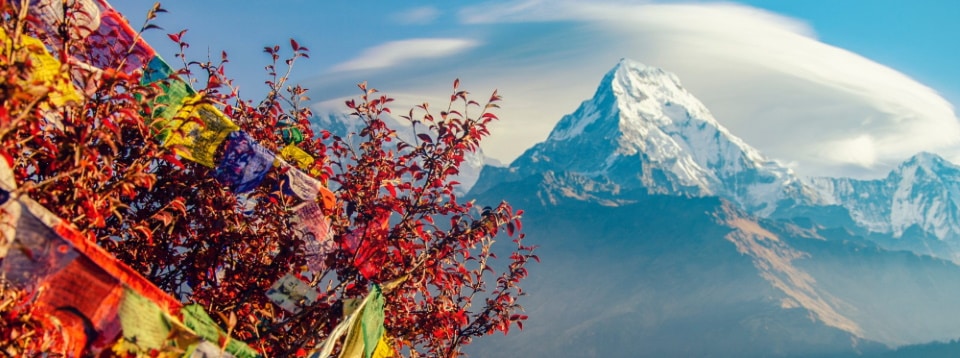Nepal Climate & Rainfall Averages

Page updated – 02 September 2024
Nepal’s Climate:
Nepal is, in theory, a year-round destination with different offerings during different seasons. For culture, heritage & sightseeing, any time of year can be rewarding. Having said that there will be the obvious road travel challenges during the monsoon (JUN-SEP) and also, there is very limited mountain viewing during this rainy season when most of the rain falls later in the day and at night. There are 2 main trekking seasons in Nepal; spring (late FEB-MAY) and autumn (late SEP-NOV).
Spring Season (February – May):
This season is ideal for touring and trekking throughout all regions of Nepal. It is particularly suitable to trek during the months of March and April in the Everest, Annapurna, Langtang and other regions as the Rhododendrons (Nepal’s national flower of which there are over 16 varieties) are in bloom at this time. The weather is fresh and crisp with low humidity; the sun is not too hot and night-time temperatures are very comfortable even when camping. This is also an ideal time for visiting Chitwan National Park & Bardia NP for jungle safaris with good opportunities for wildlife spotting minus the heat!
Monsoon Season (June-August):
Early June is actually a very good time to visit…..tourist numbers are low and you have many important sights all to yourself. Well worth putting up with a few showers of rain for! During the late June to end August monsoons the light has an amazing clarity and the land grows green and lush with astonishing speed. This time of the year is still good for cultural exploration tours, particularly in the areas of Kathmandu, Bhaktapur and Pokhara, when ripe paddy fields glisten in the sun and there is a different kind of magic created by the monsoon.
Autumn Season (September- November):
September, October and November are pleasant months with some important and colourful festivals to enjoy both in the valleys and in the mountains. This season is ideal for cultural touring, trekking and Jungle Safaris to Chitwan or Bardia National Parks. October is the busiest trekking month as well as for general tourism, so just like Bhutan it’s worth considering delaying your tour/trek to late November, December, and even far as January to avoid the tourist rush.
Winter Season: (December-January):
There is no snow in the Kathmandu and Pokhara valleys, so December and January are perfect months to visit. There are fewer tourists and contrary to what most guide books say (due most likely to climate change) climatic conditions favorable for viewing Himalayan vistas are turning up in December and January. Although treks to the Annapurna Circuit and Everest Base Camp should be avoided at this time, medium and easy grade cultural treks to all regions can be made. Christmas in the Everest region or the Chitwan Jungle makes a holiday to remember.
OR CALL BHUTAN & BEYOND THE BHUTAN, INDIA & NEPAL TRAVEL EXPERTS:
James – 0412 416 111, Nicola – 0413 598 669
Average Temperatures in Nepal Based on Minimum and Maximum
MONTH
JANUARY
FEBRUARY
MARCH
APRIL
MAY
JUNE
JULY
AUGUST
SEPTEMBER
OCTOBER
NOVEMBER
DECEMBER
KATHMANDU
Min 02 Max 19
Min 04 Max 20
Min 08 Max 25
Min 11 Max 30
Min 16 Max 30
Min 20 Max 30
Min 21 Max 30
Min 20 Max 29
Min 19 Max 27
Min 15 Max 23
Min 04 Max 20
Min 02 Max 20
POKHARA
Min 08 Max 20
Min 08 Max 21
Min 11 Max 27
Min 16 Max 30
Min 19 Max 30
Min 20 Max 30
Min 21 Max 30
Min 21 Max 30
Min 20 Max 29
Min 18 Max 27
Min 11 Max 23
Min 08 Max 22
CHITWAN
Min 07 Max 24
Min 08 Max 26
Min 12 Max 33
Min 18 Max 35
Min 20 Max 35
Min 20 Max 35
Min 24 Max 33
Min 24 Max 33
Min 22 Max 32
Min 18 Max 31
Min 12 Max 29
Min 08 Max 24
Average Rainfall in Nepal (in mm)
MONTH
JANUARY
FEBRUARY
MARCH
APRIL
MAY
JUNE
JULY
AUGUST
SEPTEMBER
OCTOBER
NOVEMBER
DECEMBER
KATHMANDU
25 mm
25 mm
75 mm
50 mm
100 mm
225 mm
375 mm
360 mm
175 mm
50 mm
10 mm
10 mm
POKHARA
15 mm
15 mm
30 mm
50 mm
300 mm
575 mm
800 mm
700 mm
575 mm
220 mm
20 mm
5 mm
CHITWAN
10 mm
10 mm
10 mm
15 mm
200 mm
300 mm
500 mm
450 mm
400 mm
100 mm
5 mm
5 mm
